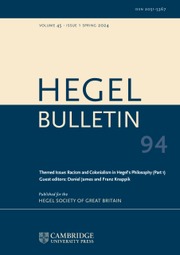No CrossRef data available.
Article contents
Hegel's Philosophy of Sound
Published online by Cambridge University Press: 18 July 2023
Abstract
This essay offers an introduction to Hegel's philosophy of sound as elaborated in the 1830 Encyclopaedia of the Philosophical Sciences in Basic Outline. The first section begins with essential context for interpreting the a priori status of nature and sound in Hegel's Philosophy of Nature. Next, I develop a general account of the Aristotelian character of Hegel's ‘Physics’, and a commentary on the categories of specific gravity and cohesion leading up to sound (and heat) in the ‘Physics of Particular Individuality’. The second section provides an exegetical portrait of Hegel's metaphysics of sound. I first reconstruct Hegel's ontology of sound from the subsection on ‘Sound’ (Der Klang), and then outline his theory of auditory perception. The third section compares Hegel's philosophy of sound to leading views in contemporary philosophy of sound. I argue that Hegel offers a hylomorphic version of a located event theory of sound, which I suggest is more phenomenologically adequate than the modern acoustic view, and more metaphysically consistent than other distal event theories of sound.
Information
- Type
- Research Article
- Information
- Copyright
- © The Author(s), 2023. Published by Cambridge University Press on behalf of The Hegel Society of Great Britain


